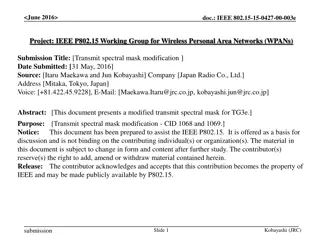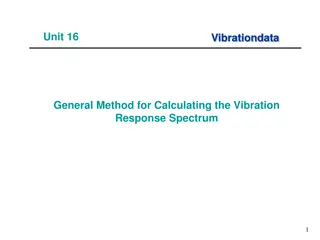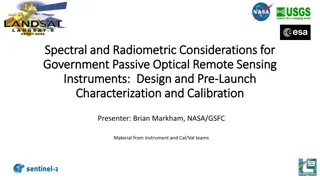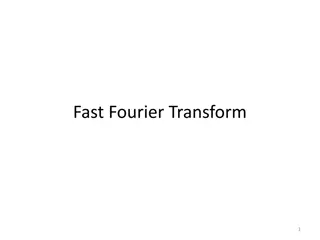Enhanced Spectral NITF Implementation Profile (SNIP) Version 1.2 Overview
This document outlines the Spectral NITF Implementation Profile (SNIP) version 1.2, its development, applications, and new elements. SNIP is a mandated standard for EO still imagery on DoD and IC systems, aiming to reduce integration costs and meet advanced exploitation needs for future HSI systems.
2 views • 14 slides
Influence of Solar Activity and Orbital Motion on Terrestrial Atmosphere
Solar magnetic field reversal, wavelet spectral analysis, and proxies for solar activity index are discussed in relation to the joint effects of solar activity and solar orbital motion on the Earth's atmosphere. The study highlights the impact of solar cycles on terrestrial climate dynamics and temp
6 views • 16 slides
Exploring Brain Waves Through EEG Analysis
Delve into the world of brain waves with EEG, EKG, and EMG measurements. Learn how to analyze brain wave data using mathematical processes like Fast Fourier Transform (FFT) and Power Spectral Density (PSD). Discover the significance of different frequencies in brain wave signals and how they reflect
1 views • 13 slides
Dynamic Subchannel Operation in IEEE 802.11-23/1892r0: Enhancing Spectral Efficiency
The document discusses the implementation of Dynamic Subchannel Operation in IEEE 802.11 to address underutilization of bandwidth by narrowband devices. By allowing dynamic switching to secondary subchannels, the aim is to maximize spectral efficiency and enable communication with narrowband STAs on
0 views • 9 slides
Exploring a Cutting-Edge Convolutional Neural Network for Speech Emotion Recognition
Human speech is a rich source of emotional indicators, making Speech Emotion Recognition (SER) vital for intelligent systems to understand emotions. SER involves extracting emotional states from speech and categorizing them. This process includes feature extraction and classification, utilizing tech
1 views • 15 slides
Geophysics Field Testing Workshop: Methods and Interpretation
This workshop on geophysics field testing covers a range of methods such as downhole and surface testing, spectral analysis, seismic refraction, and more. Geophysical investigations help assess subsurface properties efficiently and non-invasively, offering valuable insights for site exploration and
1 views • 16 slides
Rate Optimization in Wideband RIS-assisted Wireless Systems
This research focuses on rate optimization in wideband RIS-assisted wireless systems, specifically investigating MIMO RIS-assisted systems in sub-6 GHz mmWave settings. Pathloss and blockage modeling, along with LOS vs. spectral efficiency and RIS-UE distance vs. spectral efficiency analyses, are ke
0 views • 4 slides
802.11ax Evaluation for IMT-2020 eMBB in Dense Urban Environments
The document presents a detailed analysis of the 802.11ax technology's performance in meeting IMT-2020 requirements for eMBB in dense urban settings. It includes results from simulations evaluating peak spectral efficiency, data rates, user experience, and mobility metrics. The study confirms 802.11
0 views • 14 slides
Evaluation of IEEE 802.11ax for IMT-2020 eMBB Dense Urban Test Environment
This document discusses the evaluation of IEEE 802.11ax technology in the context of the IMT-2020 Enhanced Mobile Broadband (eMBB) Dense Urban test environment. It analyzes the performance of 802.11ax in meeting the key PHY/MAC metrics required for eMBB Dense Urban scenarios, such as Peak Spectral E
2 views • 13 slides
Pure Shift NMR Workshop: Advancements and Insights
Explore the latest developments and insights in Pure Shift NMR spectroscopy through presentations on acquisition methods, implementations, and the quest for spectral purity. Discover the evolution of magnet development and the potential of high-temperature superconductivity in NMR technology. Delve
2 views • 27 slides
Understanding Ultraluminous X-ray Sources (ULXs) Properties
Explore the timing and spectral properties of Ultraluminous X-ray Sources (ULXs) through research conducted by Middleton, Gladstone, Roberts, Done, Uttley, and others. Learn about the spectral shapes, spectral deconvolutions, variability in X-ray spectra, timing tools, classification into low and hi
0 views • 23 slides
Quantum Query Complexity Measures for Symmetric Functions
Explore the relationships between query complexity measures, including quantum query complexity, adversary bounds, and spectral sensitivity, in the context of symmetric functions. Analysis includes sensitivity graphs, the quantum query model, and approximate counting methods. Results cover spectral
0 views • 19 slides
CAMSS Meteoroid Elemental Abundance Application and Modeling Development
Cameras for All-sky Meteor Surveillance Spectroscopy (CAMSS) aims to obtain meteoroid elemental abundances through relative ratios and absolute atom counts, sampling from comets and asteroids. The system uses grating cameras with high resolutions to automate spectral analysis processes. The CAMSS Co
0 views • 14 slides
Introduction to Data Analysis in Geophysics with Seismic Analysis Code - SAC Lab 2.1
Explore the world of geophysics data analysis using the SAC Lab 2.1 code. Learn about seismic analysis, Fourier transform analysis, spectral analysis, color tracing, integration, differentiation, and more. The SAC online documentation provides valuable resources for users to delve deeper into this f
0 views • 45 slides
Aeroacoustic Analysis of Launch Vehicle Ascent Dynamics
Investigate the vibroacoustics of launch vehicle ascent, focusing on the formation of turbulent boundary layers, aerodynamic excitation sources, and dynamic pressure coefficients. Learn about the transition to turbulent flow, shockwave formation, and the analysis steps involved in determining vibrat
0 views • 30 slides
Exploring High Redshift Quiescent Galaxies with NIR Studies
Introduction to the fascinating world of high redshift quiescent galaxies, focusing on the importance of studying cosmological distances, photometry probes, and the challenges of identifying NIR-dark galaxies. The research delves into SED fitting parameters and the use of ALMA for spectral energy di
0 views • 8 slides
Understanding Infrared Spectroscopy: An Overview of Vibration Energy and Spectral Regions
Infrared spectroscopy involves analyzing absorption spectra resulting from changes in vibration and rotation energy in molecules. The infrared region spans from 0.8 to 200 μm, with distinct zones categorized based on wavenumber and wavelength. Group frequencies and fingerprint regions offer detaile
1 views • 26 slides
Modification of Nucleon Spectral Function in Nuclear Medium from QCD Sum Rules
Investigating the modification of nucleon properties in the nuclear medium using QCD sum rules, focusing on hadron properties, mass spectrum, and chiral symmetry restoration. The study discusses the mass differences, non-perturbative contributions, and the analysis of QCD sum rule in nuclear matter.
0 views • 27 slides
Exploring Wind Episodes in BZ Cam at Indiana University
A study conducted by collaborators at Indiana University delves into wind episodes in BZ Cam, a Nova-like CV, revealing variability, optical characteristics, and orbital ephemeris challenges. Spectral analysis, duty cycles, and episodic properties are explored, providing insight into the nature of w
0 views • 27 slides
Detailed Review of R-Alice PDS Data - Southwest Research Institute
Content discusses the R-Alice PDS data review conducted by Cesare Grava from Southwest Research Institute. It includes details on FUV imaging spectrograph specs, objectives of R-Alice, study goals related to comet nucleus, atomic budget analysis, and spectral mapping of 67P/CG nucleus at FUV wavelen
0 views • 14 slides
Insights into UV/VIS Backscattered Sun Light Retrievals from Space-Born Platforms
Explore the history, instruments, and future of UV/VIS backscatter spectrometers, including a comparison of TOMS and OMI systems, the GEO constellation, and examples of data retrievals. Dive into the discovery of the ozone hole and the advancements in atmospheric chemistry analysis by USA, Europe, a
0 views • 41 slides
Charge Transport Model for Swept Charge Devices (SCD) in Astrophysics Research
Exploring the charge transport model for Swept Charge Devices (SCD) in collaboration with various institutions like ISRO Satellite Centre and e2V technologies Ltd. The research aims to enhance spectral response, reduce uncertainties, and improve global lunar elemental mapping using advanced X-ray sp
0 views • 30 slides
Performance Review of STAR's CrIS SDR Calibration and Validation Task
This document provides an overview of the performance review conducted on the CrIS SDR Calibration and Validation Task at the STAR Review Meeting in October 2012. Tasks include managerial and technical leadership, trending and monitoring of instrument data quality, inter-sensor comparisons, measurem
0 views • 24 slides
Role of Solvent in Spectral Properties and Solvatochromism
Solvent plays a crucial role in physical and chemical processes, affecting kinetics, equilibria, and spectral properties such as UV-vis, IR, and NMR. Solvathochromism describes the change in spectral bands caused by solvent interactions. Factors like solvent polarity and hydrogen bonding influence d
0 views • 19 slides
Developing a Graphical User Interface for High-Resolution X-ray Spectra Analysis
High-resolution X-ray spectra analysis can be challenging due to the complex nature of the information contained within. This project aims to simplify the process by developing a user-friendly graphical interface that enables users to visualize, analyze, and interpret X-ray spectra data effectively.
0 views • 19 slides
Insights into Cosmic Ray Spectrum Breaks and Hardening after Centuries of High-Resolution Measurements
Spectral breaks in cosmic ray (CR) spectrum reveal rigidity-dependent behaviors, such as proton break at 240 GeV and remarkable hardening post-breaks. Various experiments like PAMELA, ATIC, CREAM II, and others showcase unique features and spectral indices, shedding light on CR composition and accel
0 views • 15 slides
Mapping Soil Organic Carbon Fractions in Australia: Stocks and Uncertainty
This study by Mercedes Román Dobarco et al. focuses on mapping soil organic carbon fractions across Australia, including mineral-associated organic carbon, particulate organic carbon, and pyrogenic organic carbon. The research involves prediction of soil organic carbon fractions using spectral libr
0 views • 17 slides
Modified Transmit Spectral Mask for IEEE P802.15 Working Group
This submission presents a modified transmit spectral mask for TG3e by Japan Radio Co., Ltd. The proposed mask aims to improve power efficiency without violating radio regulations. The motivation for the modification is to reduce unwanted aliasing and enhance SNR by employing a steep anti-aliasing s
0 views • 17 slides
Understanding Yukawa Textures and Spectral Data in Computing
Exploring the low energy limit of the Heterotic string, focusing on Yukawa couplings and spectral data in the context of Calabi-Yau threefold and Weierstrass elliptically fibered CY3. The goal involves direct computation of challenging cohomologies and utilizing Fourier-Mukai transform for bundle co
0 views • 17 slides
Spectral Characteristics of Infrared Sounders: Overview and Comparison
This presentation discusses the spectral characteristics of classic and smallsat types of infrared sounders, focusing on key parameters of LEO hyperspectral IR sounder sensors, spectral coverage, resolution, sampling, as well as the impact of spectral bands on power consumption and volume in smallsa
0 views • 4 slides
Vibration Response Spectrum Analysis for SDOF Systems
This article covers the calculation of the Vibration Response Spectrum for Single-Degree-of-Freedom (SDOF) systems subjected to base excitation using a general method equation. It explains how to determine the response for a family of natural frequencies and plot the results as VRS. The content incl
0 views • 16 slides
Spectral and Radiometric Considerations for Government Remote Sensing Instruments
This presentation explores the important considerations in designing and calibrating government passive optical remote sensing instruments, focusing on spectral and radiometric aspects. Topics include spectral variation, design considerations, uniformity, reflectance calibration, and examples from i
0 views • 27 slides
IEEE 802.11-21 Spectral Mask Floor Considerations
This document discusses the considerations related to changing the absolute power spectral density (PSD) floor for IEEE 802.11-21 transmissions. It covers requirements from regulatory bodies like ETSI and FCC, as well as considerations for coexistence with technologies like 5GNR. The document also h
0 views • 10 slides
PySAT Point Spectra Tool: Spectral Analysis and Regression Software
PySAT is a Python-based spectral analysis tool designed for point spectra processing and regression tasks. It offers various features such as preprocessing, data manipulation, multivariate regression, K-fold cross-validation, plotting capabilities, and more. The tool's modular interface allows users
0 views • 6 slides
SUNSTORM: Advanced X-ray Technology for Solar Measurements
SUNSTORM, also known as XFM, is a cutting-edge technology designed specifically for measuring X-rays from the Sun, tailored for Space Weather monitoring. It offers high spectral and time resolution, a wide spectral range, and a large dynamic range, making it ideal for various scientific studies rela
0 views • 4 slides
Insights into Binning and Response Matrices for Spectral Analysis
Understanding the impact of binning and response matrices in spectral analysis, including energy bin properties, flux evaluation techniques, assumptions, and strategies for improvement. The discussion delves into challenges and solutions for accurate data interpretation and modeling in high-resoluti
0 views • 20 slides
NMR Spectroscopy Data Analysis for Organic Compounds
This dataset contains NMR spectroscopy data for various organic compounds, including their chemical shifts (ppm), peak areas, and molecular formulas. The information can be used for spectral analysis and identification of chemical structures.
0 views • 20 slides
Enhancing Spectral Efficiency Through Nonprimary Channel Access in IEEE 802.11
IEEE 802.11 is exploring nonprimary channel access to address underutilization of spectrum and improve latency and throughput. This approach involves enabling nonprimary channel access with simple modifications to existing rules, such as limiting TXOP duration and using control frames for coordinati
0 views • 13 slides
Understanding Smoothing, Correlation, and Spectra in Environmental Data Analysis
Explore the interrelationships between smoothing, correlation, and power spectral density in environmental data analysis through topics like autocorrelation, cross-correlation, Fourier series, and more. Learn how to apply these concepts using MatLab for effective data analysis.
0 views • 81 slides
Understanding Fast Fourier Transform (FFT) in Signal Processing
Fast Fourier Transform (FFT) is a powerful algorithm used in signal processing to efficiently calculate the Discrete Fourier Transform (DFT). This advanced technique leverages symmetry and periodicity properties to reduce computational complexity, making it a key tool in digital signal analysis. By
0 views • 14 slides







































